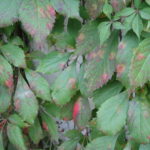As discussed by phone here are photo’s of our Virginia Creeper showing what we believe to be a fungus problem. Please confirm that that you suspect that this is fungus and also whether you see any other problems in addition to the fungus.
Thank you for providing us with a photo of your Virginia Creeper. It is always easier to assess a problem once we can visualize the damage.
Due to the rainy cool weather we had this season, we are noticing an increase in fungal diseases. Perhaps this is why you have not noticed it in past years. Fungi and bacteria cause spots on plant leaves, in a variety of colors, shapes and sizes. In some cases the spots may spread to cover entire leaves, stunting plant growth. Generally if the disease is not too extensive then it will not have a major impact on your vine, but if your vine undergoes heavier infestations in several successive years, this can weaken your vine.
Your spots are most likely caused by the fungus Guignardia bidwellii. Guignardia leaf spot is a common fungal leaf spot that affects vining plants such as Boston ivy and Virginia-creeper. According to the University of Wisconsim:
“Symptoms of Guignardia leaf spot include roughly circular, or sometimes angular, ¼ to ½ inch diameter dead spots on affected leaves. Spots often have a purple-red border, and the centers may eventually fall out. Young leaves are more susceptible to infection than mature leaves. If infections occur before leaves fully expand, leaves can become puckered and distorted. Within individual leaf spots, a diffuse ring of black dots (reproductive structures of the pathogen) is typically visible”. https://hort.uwex.edu/articles/guignardia-leaf-spot/
The fungus overwinters on fallen leaves. In spring following wet weather, spores form and are dispersed by wind to new leaves where they cause infection. The initial leaf infections form spots and more spores are produced in the spots. These spores are rain splashed to infect other leaves. Secondary spread and infection by spores continues repeatedly, whenever wet, warm weather occurs, until leaves fall in autumn.
You cannot get rid of of the infection this year. However cultural controls such as good pruning to allow for rapid drying of foliage, disposal of the infected leaves and avoid wetting the foliage while watering the vines will all aid in helping to reduce the spread of the fungus. It is important not to dispose of the infected leaves in your own compost pile instead place them in a bag for the city yard waste program. The city is able to heat the waste to a higher temperature and thus kill the spores. Make sure to clear the ground of plant debris around the infected plant in the fall to eliminate overwintering spores.
Next spring you can spray with a sulpher based fungicide available at your local garden centre. Make sure you follow the directions on the label.
The best prevention for spread of diseases and pests is making sure you have a healthy vine along with good cultural practices.


